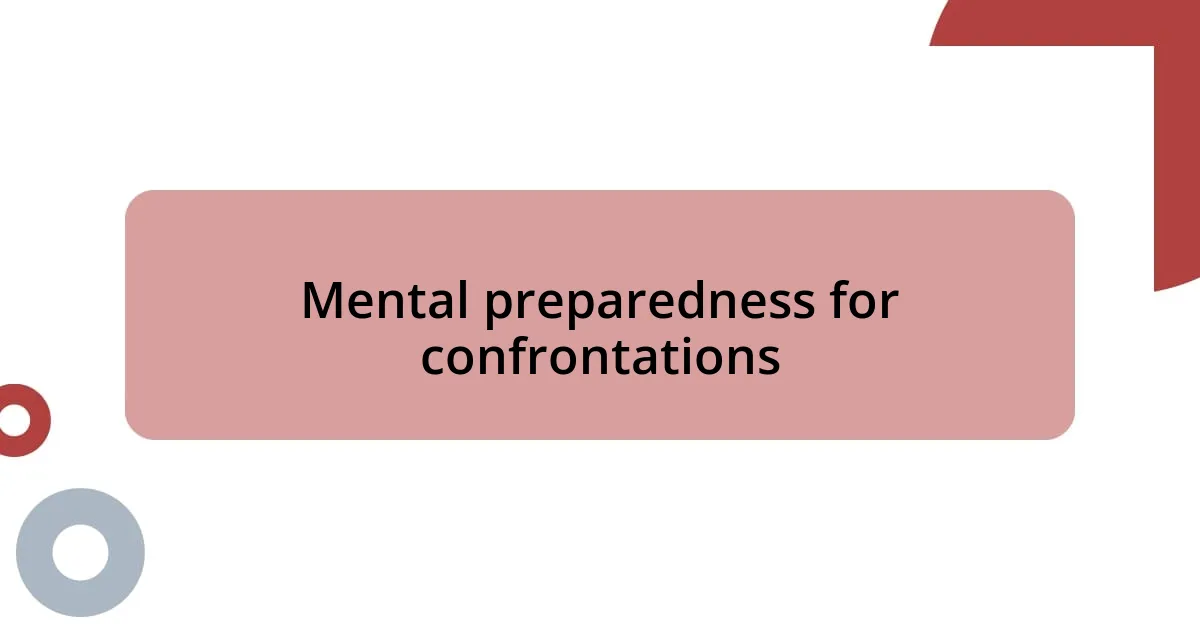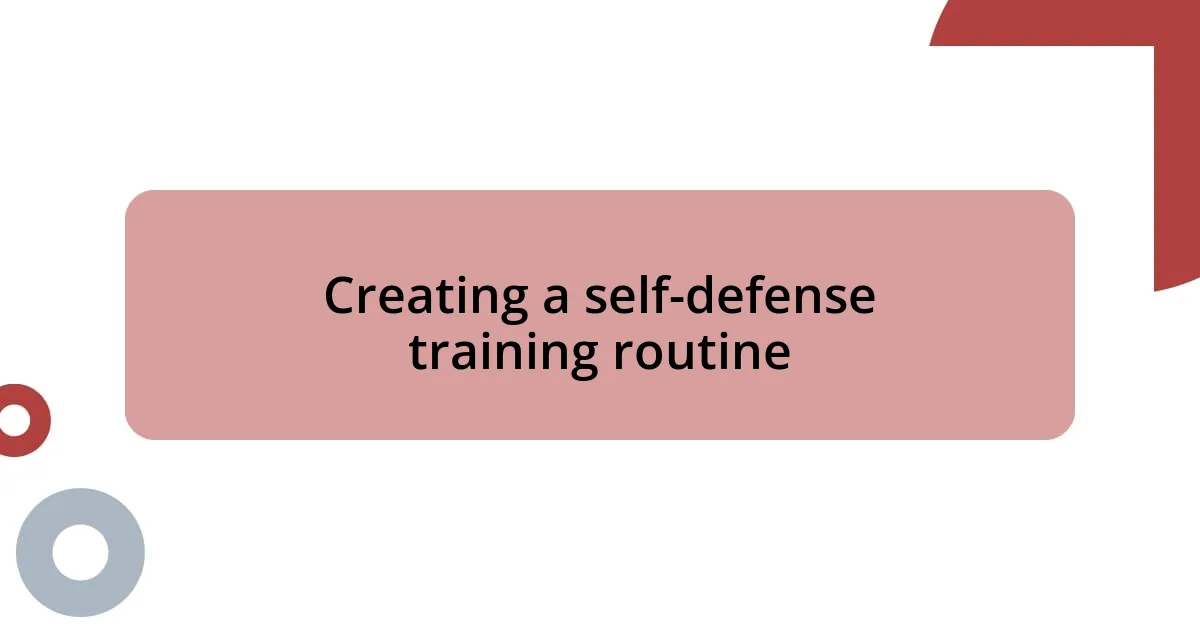Key takeaways:
- Self-defense training emphasizes the importance of awareness, distance management, and consistent practice for effective threat response.
- Choosing the right self-defense style should consider personal preferences, physical condition, and the quality of instructors and community support.
- Physical fitness enhances stamina and strength, crucial for handling confrontational scenarios confidently.
- Mental preparedness, including visualization and deep breathing, is essential for maintaining control and clarity during confrontations.

Understanding self-defense principles
Understanding the fundamental principles of self-defense is essential for anyone looking to feel empowered and secure. For me, it’s not just about physical techniques; it’s also about mindset. I often think, how can I remain calm and assess a situation effectively when adrenaline kicks in?
One principle that resonates with me deeply is the importance of awareness. In a recent self-defense class, I remember a moment when I felt the shift in energy around me. I realized that being aware of my surroundings is a powerful tool. It’s about anticipating potential threats before they escalate, which often means trusting your instincts, even if it feels uncomfortable.
Another key principle is to create distance from an aggressor. I vividly recall practicing distance management drills, which highlighted how even a few steps back can give you time to think and react. This not only boosts your physical safety but also your emotional confidence. The simple question is: how can we effectively create that space in a real-life situation? Through continuous practice and understanding these principles, we equip ourselves to handle threats more effectively.

Choosing the right self-defense style
Choosing the right self-defense style can feel overwhelming given the many options available. It’s important to reflect on your personal goals, physical abilities, and the context in which you’ll be using these skills. I remember attending a seminar that explored various styles. Watching demonstrations from Brazilian Jiu-Jitsu to Krav Maga, I realized that each had its unique flavor. Personally, I gravitated towards styles that emphasize situational awareness and practical techniques over complicated movements.
When deciding on a self-defense style that suits you best, consider the following factors:
– Personal Preference: Do you prefer striking or grappling techniques?
– Physical Condition: Are you looking for a style that suits your fitness level and body type?
– Application Context: Will you be training for urban self-defense, competition, or home safety?
– Instructor Quality: Is the instructor experienced, approachable, and aligned with your goals?
– Community Support: Is there a local community or network that can provide encouragement and motivation?
By exploring these elements thoroughly, you can find a style that not only equips you with effective techniques but also resonates with you personally. For me, finding a supportive community within my chosen style made all the difference; it turned training into both a resource and a rewarding experience.

Key techniques to practice regularly
Practicing specific techniques regularly is vital for retaining muscle memory and developing confidence in self-defense situations. One technique I focus on is the basic striking motion, specifically the jab. In one of my training sessions, I distinctly remember the clarity that came with each punch—quick and directed. This foundational movement is not only effective in creating space but also builds the confidence needed to engage if necessary.
Another technique that stands out to me is the escape from holds. I have been in scenarios where, through proper grip-breaking drills, I felt the shift in control during sparring. It’s fascinating how a well-practiced escape can be instinctual. Practicing this technique routinely can dramatically increase your chances of getting free from an unwanted situation. It’s a heart-pounding reminder of how crucial each moment can be in a real threat.
Lastly, practicing situational awareness drills, such as role-playing with a partner, has offered me profound insights. I recall a particular exercise where my partner would approach me randomly, simulating potential threats. Each time, I could feel the adrenaline rise; yet, focusing on my responses and practicing de-escalation techniques grounded me. This type of practice is essential for turning knowledge into reflex, ensuring you’re not just reactive, but proactive in adverse situations.
| Technique | Benefits |
|---|---|
| Basic Striking | Builds muscle memory and confidence |
| Escape from Holds | Increases chances of freeing oneself during a confrontation |
| Situational Awareness Drills | Enhances preparedness and proactive responses |

Importance of physical fitness
Physical fitness plays a crucial role in self-defense training, and I’ve come to appreciate this firsthand. I remember the first time I struggled to keep up during a sparring session; it was humbling and eye-opening. Feeling out of breath while trying to execute techniques made me realize that being in shape isn’t just about aesthetics; it’s about having the stamina and strength to defend myself effectively.
Consider the physical demands of self-defense situations. When faced with an assailant, your body needs to react quickly and intelligently. In one of my training sessions, we practiced a scenario where I had to escape from an unexpected hold. I felt how much more confident I was because I had been working on my cardio and overall strength. It reinforced my belief that a fit body can translate to mental resilience—something vital when under pressure.
I often ask myself: how can I expect to defend against a threat if I don’t invest in my physical fitness? Each drop of sweat during workouts transforms into preparation for the unpredictable. Maintaining that fitness not only boosts my ability to perform techniques but also fosters a sense of empowerment. The journey towards fitness and self-defense is intertwined, making every training session a step closer to being ready for whatever comes my way.

Mental preparedness for confrontations
When it comes to mental preparedness for confrontations, I believe a strong mindset is just as crucial as physical skills. I remember my first self-defense class, feeling a surge of nerves as I contemplated an actual conflict. I soon learned that visualizing potential scenarios helped me build mental resilience. By imagining different outcomes and practicing my reactions in my mind, I could face uncertainty more calmly—a technique I still use today.
A core part of getting mentally ready is understanding your emotions in a confrontation. The first time I found myself confronted by an aggressive stranger during a late-night walk, my heart raced and thoughts scattered. Reflecting on that experience later, I realized how vital it was to acknowledge and accept my feelings. By doing so, I’ve trained my mind to shift from panic to focus, allowing me to respond more effectively when faced with danger.
I often ask myself: what could I do in a tense situation to maintain control? For me, deep breathing has been a game changer. Picture this: standing your ground while inhaling deeply and exhaling slowly. It sounds simple, but during those crucial moments, it allows me to regain composure. By integrating these mental strategies into my self-defense training, I not only bolster my confidence but also arm myself with the clarity needed to navigate challenging interactions.

Creating a self-defense training routine
Creating a self-defense training routine involves thoughtful planning and consistency. For me, setting aside specific days of the week for training has made a world of difference. I remember when my schedule was all over the place, leaving me with sporadic practice sessions that didn’t seem to build much skill. By committing to a routine, I found that I not only improved faster but also developed a sense of discipline that translated into greater confidence in my abilities.
I’ve discovered that incorporating various elements into my training keeps it engaging and well-rounded. Some days I focus on physical conditioning, while others are dedicated to technique drills or sparring. There was a period when I hit a plateau in my skills, and it was frustrating. Then, I decided to mix in high-intensity interval training (HIIT) with my self-defense practice. Not only did it break the monotony, but it also helped me develop better endurance, which is crucial in real-life situations. How can you expect to respond effectively if you haven’t trained in diverse scenarios?
Finally, it’s important to listen to your body and adjust your routine as necessary. I’ve had weeks where I felt overwhelmed and burnt out, and during those times, I learned to prioritize recovery. Taking a step back to rest has often been what led to more meaningful growth. By being attuned to my needs, I’ve created a sustainable training routine that balances intensity with recovery—a key factor that has enabled me to stay committed for the long haul. Wouldn’t you agree that listening to your body could be the secret ingredient in your training success?

Evaluating your progress and improvement
Evaluating your progress in self-defense training is a continual and reflective process. I remember tracking my techniques through weekly sparring sessions; at first, I felt overwhelmed by the complexity of my movements. But after recording my sessions and assessing both my strengths and weaknesses, I could see clear patterns of improvement. Have you ever documented your sessions? I found that this practice not only highlighted my progress but also kept me motivated.
It’s also important to not just rely on self-assessment. Engaging with training partners or instructors for feedback has been invaluable in my journey. Once, a mentor pointed out that while my strikes were powerful, my footwork needed work. At first, I felt defensive, but later, I appreciated the constructive criticism that pushed me to refine my skills. Don’t hesitate to ask for opinions; sometimes outsiders can see what we, as practitioners, might overlook. How often do you seek out feedback during your training?
Finally, I genuinely believe that embracing setbacks is essential for growth. There was a time when I struggled with a specific technique for weeks—it felt like hitting a wall. But instead of getting frustrated, I decided to approach it with curiosity, looking into online resources and asking others for their tips. This shift in mindset helped me eventually master that technique, and it became a keystone moment in my training journey. It made me realize that every challenge holds the potential for advancement. What obstacles have you faced, and how have they shaped your training evolution?














